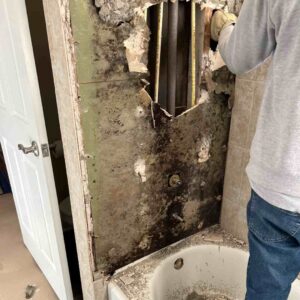When performing a bathroom remodel, it’s common to encounter mold presence during the demolition phase. The kitchen and the bathroom are the 2 wettest locations in any home and are therefore most susceptible to mold growth. Mold needs water, food, and adequate temperatures to grow and reproduce. Bathrooms are therefore mold utopias. What should you NOT do during a bathroom remodel if you see mold? Read on to learn some tips!
What Shouldn’t You Do if You Encounter Mold Presence?
As you’re tearing away tub/shower surrounds and sink backsplashes, if you uncover mold, the first thing to do is to STOP everything and call a mold testing company to come out and determine the best protocol for mold removal. Here’s what NOT to do when you find mold:
- Tear out the affected materials
- Spray the materials with bleach
- Install new materials over the affected area(s)
Don’t Tear Out the Affected Materials
Mold spores can take up to 8 hours to fall to the floor once airborne. They easily aerosolize and end up in your home’s ventilation system–spreading the mold to the rest of your home. Mold spores are how mold reproduces itself.

Think of spores like seeds on a dandelion flower. When you blow the seeds of a dandelion plant, they easily spread everywhere in the immediate vicinity. However, mold spores are so tiny that they cannot be seen with the naked eye. Depending on the species, mold spores are anywhere from 1-30 micrometers in size. For example, you could easily fit thousands of mold spores end-to-end on a 1-inch line.
Therefore, before tearing out affected materials like drywall, it’s important to set up containment, dehumidification, and air scrubbers. The air scrubbers are used to create negative air pressure in the bathroom and filter out mold spores before sending the clean air into the rest of the home. This process should be determined by a mold tester and left to a mold remediation company. Proper containment will keep the mold in the affected bathroom and prevent it from spreading to other parts of the home.

When a professional removes the affected materials, they methodically place them in a contractor-grade garbage bag while in containment under negative air. Once the bag is full, it is sealed before being carried out of the containment and properly disposed of. Remediators will often wipe the outside of the bag with an anti-microbial agent in case any spores have landed on the bag’s exterior during material removal before bringing it outside of containment.

Once all of the mold removal is complete, the entire bathroom is HEPA vacuumed, and the affected wall studs are treated with an anti-microbial agent. The room is also thoroughly cleaned with an anti-microbial agent from floor to ceiling. This micro-cleaning process is often repeated multiple times over a several-day period to ensure the room is completely scrubbed of mold spores. Once this cleaning process is complete, renovation may continue and new materials may be placed.
Don’t Spray the Materials with Bleach
Many people have been misinformed over the years regarding proper mold removal. Mold presence should NOT be handled by simply spraying the area with bleach and wiping it away. Why?
- Bleach is mostly water and the chemical itself off-gases
- Dead mold is still toxic
- Mold often has “roots” or mycelium embedded in organic matter like drywall
When you spray mold with bleach, you’re feeding it more water–one of its required food sources. Bleach products only contain a small percentage of bleach. This bleach off-gases quickly and simply leaves behind water to nourish the mold.
Even if the mold is killed but not removed, its mycotoxins are still present and can cause health issues. Moreover, you may kill the fruiting bodies and/or hyphae on the surface of a material, but the mycelium (roots) are embedded underneath. Like pulling a weed in your garden, if you don’t get it up by its roots, it will just keep coming back.
Don’t Install New Materials Over the Affected Areas
Lastly, you don’t want to cut corners and simply ignore the mold. It’s important that the water source is first identified and the mold is then removed before placing new materials. Simply wiping down the area or covering it with Kilz is NOT a good solution to the mold problem.
Covering over the mold is only going to lead to problems for you down the road. Over time, when you’re consistently exposed to mycotoxins, your sensitivity to them increases. It’s the opposite effect of how your immune system responds to viruses. You, or any future homeowners will end up having to remove the new materials and deal with the mold underneath–costing you twice as much time and money. Just because you’re not sensitive today, it doesn’t mean you won’t be sensitive tomorrow.
Flo-Air Specializes In Identifying Mold Presence
When it comes to identifying mold presence and establishing effective remediation protocols, Flo-Air are industry experts here in Jacksonville, FL, and the surrounding areas. It’s important to leave mold testing and remediation to licensed and insured professionals. Don’t try to DIY mold removal or remediation!
